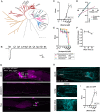Neuronally produced betaine acts via a ligand-gated ion channel to control behavioral states
- PMID: 36413500
- PMCID: PMC9860315
- DOI: 10.1073/pnas.2201783119
Neuronally produced betaine acts via a ligand-gated ion channel to control behavioral states
Abstract
Trimethylglycine, or betaine, is an amino acid derivative found in diverse organisms, from bacteria to plants and animals, with well-established functions as a methyl donor and osmolyte in all cells. In addition, betaine is found in the nervous system, though its function there is not well understood. Here, we show that betaine is synthesized in the nervous system of the nematode worm, Caenorhabditis elegans, where it functions in the control of different behavioral states. Specifically, we find that betaine can be produced in a pair of interneurons, the RIMs, and packed into synaptic vesicles by the vesicular monoamine transporter, CAT-1, expressed in these cells. Mutant animals defective in betaine synthesis are unable to control the switch from local to global foraging, a phenotype that can be rescued by restoring betaine specifically to the RIM neurons. These effects on behavior are mediated by a newly identified betaine-gated chloride channel, LGC-41, which is expressed broadly in the navigation circuit. These results implicate neuronally produced betaine as a neuromodulator in vivo and suggest a potentially similar role for betaine in nervous systems of other animals.
Keywords: C. elegans; behavior; betaine; ion channel.
Conflict of interest statement
The authors declare no competing interest.
Figures




References
-
- Nakanishi T., Turner R. J., Burg M. B., Osmoregulation of betaine transport in mammalian renal medullary cells. Am. J. Physiol. Ren. Fluid Electrolyte Physiol. 258, F1061–F1067 (1990). - PubMed
-
- Ott V., Koch J., Späte K., Morbach S., Krämer R., Regulatory properties and interaction of the C- and N-terminal domains of BetP, an osmoregulated betaine transporter from Corynebacterium glutamicun. Biochemistry 47, 12208–12218 (2008). - PubMed
-
- Yamauchi A., et al. , Cloning of a Na+- and Cl-dependent betaine transporter that is regulated by hypertonicity. J. Biol. Chem. 267, 649–652 (1992). - PubMed
-
- Lopez-Corcuera B., Liu Q. R., Mandiyan S., Nelson H., Nelson N., Expression of a mouse brain cDNA encoding novel γ-aminobutyric acid transporter. J. Biol. Chem. 267, 17491–17493 (1992). - PubMed
Publication types
MeSH terms
Substances
Grants and funding
LinkOut - more resources
Full Text Sources
Miscellaneous

